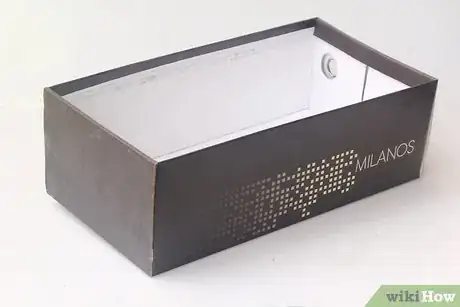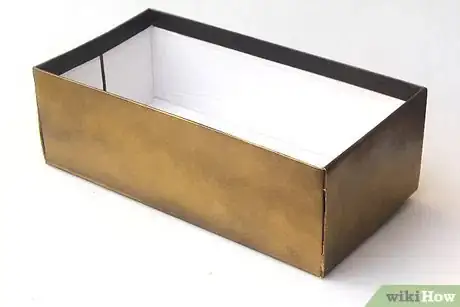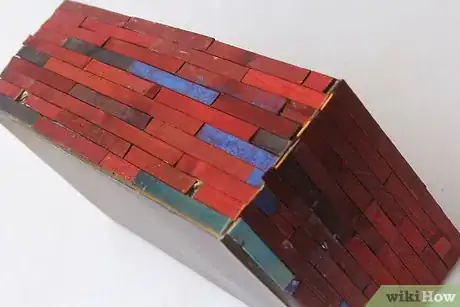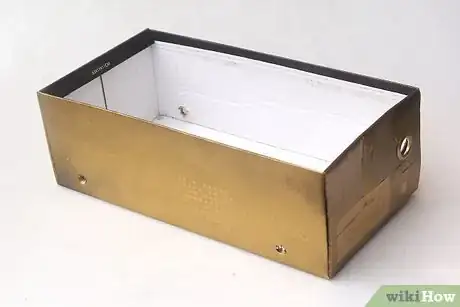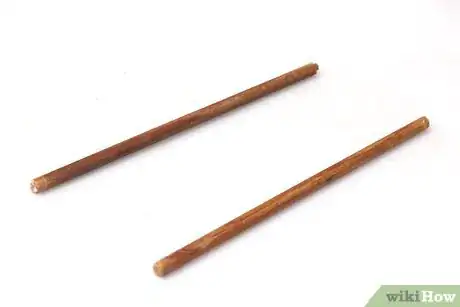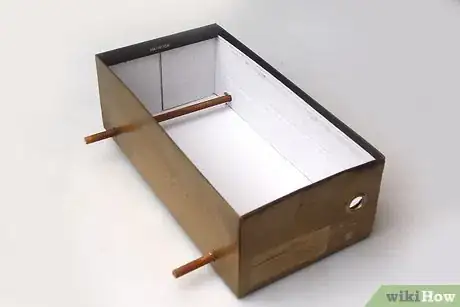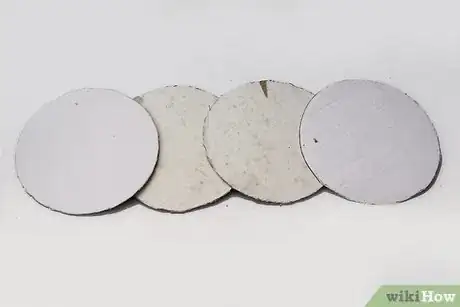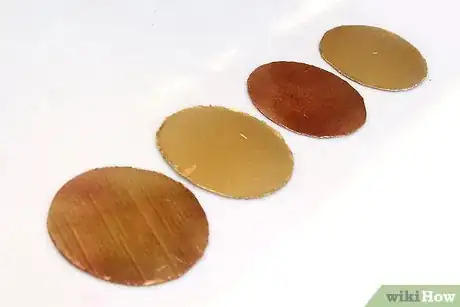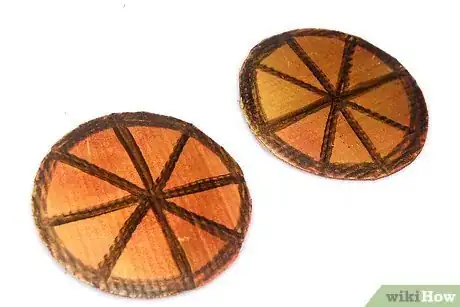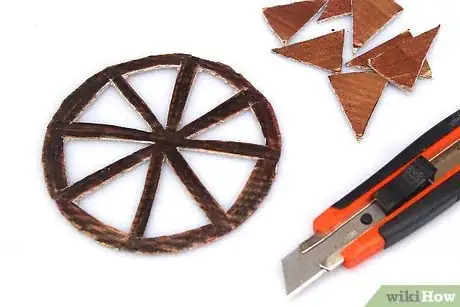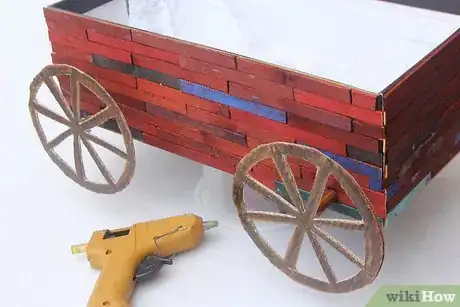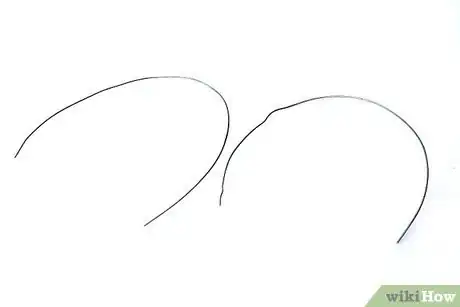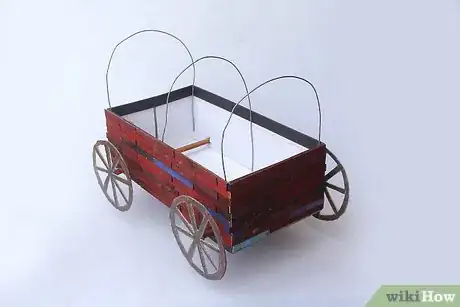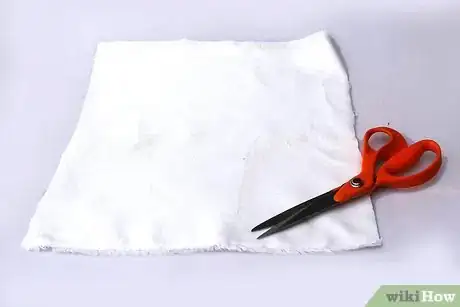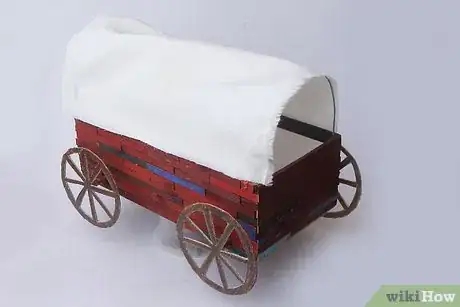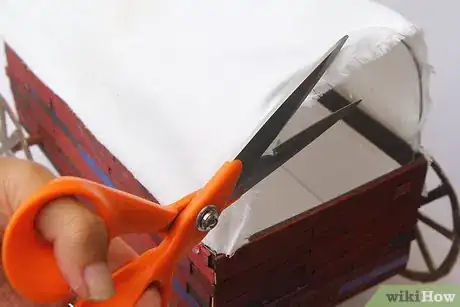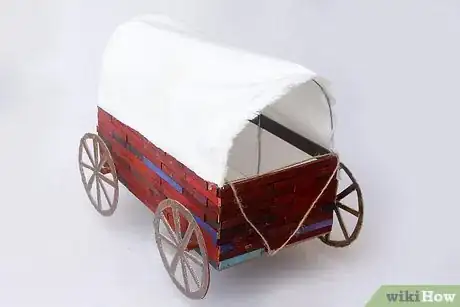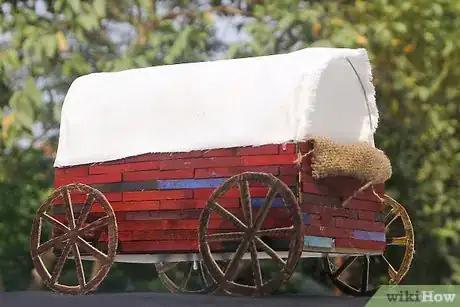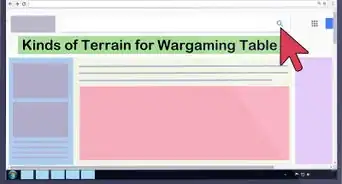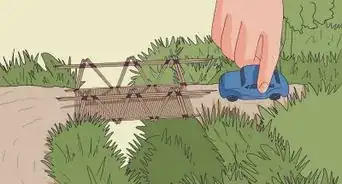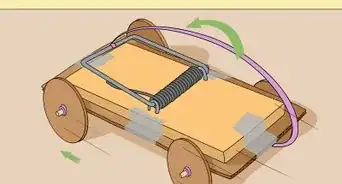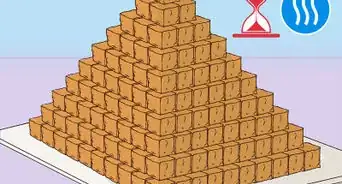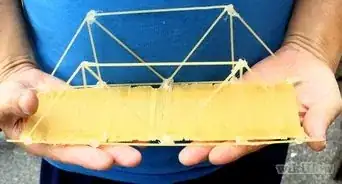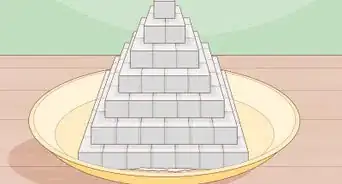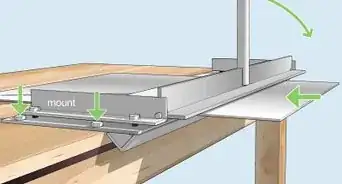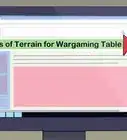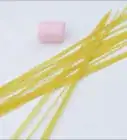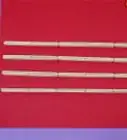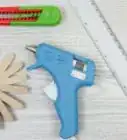This article was co-authored by wikiHow Staff. Our trained team of editors and researchers validate articles for accuracy and comprehensiveness. wikiHow's Content Management Team carefully monitors the work from our editorial staff to ensure that each article is backed by trusted research and meets our high quality standards.
This article has been viewed 81,492 times.
Learn more...
Pioneers traveled across America in covered wagons. The wagons are instantly recognizable for their wooden frames, and canvas coverings. You don't need to be a pilgrim living in America to make a covered wagon, however. With some items from around the house and a sprinkle of creativity, you can create your own miniature covered wagon that is similar to the ones that pilgrims used!
Steps
Creating the Wagon Base
-
1Find a rectangular box to use as the base of your wagon. Your box can be any size you want it to be, but shoe boxes work especially well for this project. Your box should be a little shorter than it is wide. If your box is too tall, trim it down a little.
- How much you trim down from the top of the box depends on how big the box is to begin with. Use your best judgement.
- You can even use a milk carton. Cut out one of the side panels, then trim the walls down so that they aren't so tall.
-
2Cover the sides of your box with brown construction paper. Trace the sides of your box onto a sheet of brown paper, then cut them out. Apply tacky glue or white school glue to the box with a wide paintbrush. Press the cut out shapes onto the matching sides of the box.
- If you don't have brown construction paper, you can use brown cardstock or even a brown paper bag.
- You can cover the bottom of the box, or you can leave it blank. It won't be visible in the end.
- You can paint the box brown with acrylic craft paint, as long as it does not have a waxy coating on it, like a milk carton.
Advertisement -
3Cover the box with wood craft sticks if you want a realistic wagon. Hot glue the craft sticks to each side of the wagon, staggering them like bricks on a wall. If you don't have hot glue, use tacky glue instead. Work 1 side at a time, and let each side dry before moving onto the next.[1]
- Miniature craft sticks with straight ends will work the best. If you are using the larger "popsicle" type sticks, cut off the rounded ends first.
- Enough space along the bottom edge so that you can poke holes for the axles. The space should be the same thickness as your dowels.
-
4Poke 4 holes into the long sides of the box for the axels. You will need 2 holes on each side of the box. Poke the holes into the sides of your wagon, as close to the bottom as possible. Make the holes about 1 to 2 inches (2.5 to 5.1 cm) from the front/end of your wagon. You can create the holes using a hole puncher, scissors, or a skewer. The long edges are the sides of your wagon. The narrow edges are the front and back.
-
5Cut a thin dowel into 2 identical pieces. The pieces need to be 1⁄2 to 1 inch (1.3 to 2.5 cm) longer than the narrow end of your wagon. You can cut the dowel with scissors or a craft blade. You can also snap it in half, then sand down the jagged ends.
- If you don't have thin dowels, use straws or skewers instead. If your wagon is very small, you can even use lollipop sticks!
-
6Slide the dowels through the holes to make the axels. Make sure that the dowels have enough room to spin around in the holes you just made. If you need to, use scissors to make the holes bigger. Leave about 1⁄4 to 1⁄2 inch (0.64 to 1.27 cm) of the dowel sticking out of each hole.[2]
Adding the Wheels
-
1Cut 4 identical circles out of cardboard. Trace the circles using a compass, a small lid, or a drinking glass. Make the circles about the same height as your wagon. Once you are happy with the size, cut the circles out. It would be easier to do this with a craft blade, but you don't have it on hand, you can use scissors instead.
-
2Paint the circles brown, if desired. If the cardboard is already brown, you can skip this step. If the cardboard is not brown, take a moment to paint the circles with brown acrylic craft paint and a paintbrush. Let the paint dry before moving on.
- Paint the back of the circles for a nicer finish.
-
3Draw black spokes onto the wheels. Draw 3 lines crisscrossing in the middle of each wheel, creating a large asterisk shape. You can do this with a thick black marker, or you can paint them on instead using a thin paintbrush and black acrylic paint. If you want to get more crafty, glue pieces of black yarn over the lines that you drew.
- Hot glue or tacky glue will work well for gluing the yarn to the circles. If you are using hot glue, work 1 line at a time, or it will set too fast.
-
4Cut out the spaces between the spokes if you want realistic wheels. This step can be tricky, so it could be best to get an adult to help you. Make sure that you are only cutting the triangular wedges between the spokes. Be careful not to cut into the center or the outside of the wheel.
-
5Glue the wheels onto the dowels. If the dowels are too thin and the wheels keep falling off, poke a hole in the center of each wheel, then slide the wheels onto the dowels. Secure the wheels to the dowels with drops of glue so that they don't fall off.[3]
- Make sure that the spokes are on the outside.
- The wheels must be centered. If you need to, draw an X across the back of each wheel to find the center.
Covering the Wagon
-
1Cut 2 to 3 strips out of cardstock or thin cardboard to make the arches. The strips need to be long enough to create arches when you hold the ends against the sides of the wagon. The arches should be about 3 times the height of your wagon. The color of the cardstock or cardboard does not matter because it will be on the inside.
- A small box will require 2 strips. A larger box will need 3 to 4 strips for more support.
- You can use pipe cleaners instead of cardstock or cardboard strips. Cut the pipe cleaners if they are too long. Connect multiple pipe cleaners if your box is very big.
-
2Glue the strips to form arches in the front and back of the wagon. Take your first strip and bend it into a U-shape to create your first arch. Position the arch at the front end of your wagon. Lower the ends of the arch into the wagon by about 1⁄2 to 1 inch (1.3 to 2.5 cm). Secure the arch to the inside walls of the wagon with hot glue. Repeat this step for a second arch in the back of the wagon.[4]
- You can use tacky glue for this step, but you will need to secure the strips with clothespins until the glue dries.
- If your wagon is very large, add a third arch right in the middle of the wagon.
-
3Cut a rectangle out of fabric big enough to cover the frame. Measure the length of your wagon first, then measure across 1 of the arches, from end-to-end. Cut a rectangle out of white or off-white fabric based on your measurements. White or off-white cotton fabric will work the best for this. Canvas may be more accurate, but it may crush the arches.
- You can also use white printer paper or construction paper to make the cover.
-
4Drape the fabric over the frame, and secure it with glue. Use a paintbrush to apply tacky glue to the arches. Drape the fabric over the arches and smooth out any wrinkles. If you are using paper, you may need to secure the edges of the paper to the sides of the wagon with tape until the glue dries.[5]
- If you secured the edges of the canvas to the wagon with tape, remove the tape as soon as the glue dries.
- If you used pipe cleaners, you can apply the glue to them straight from the bottle. You can also try hot glue, but work quickly so it doesn’t harden.
-
5Let the glue dry, then trim away any excess fabric, if needed. Wait a few hours for the glue to dry. If there is any fabric hanging down over the sides of the wagon, use a pair of scissors to trim them until they reach the top edge of the wagon’s side walls. If there is any fabric hanging over the front and back of the wagon, trim it down too.[6]
-
6Add a harness for horses or oxen, if desired. Cut a piece of string that is about the length of your wagon, then fold it in half. Glue each end of the string to the inside of the front wall of your wagon. Hot glue will work the best for this, but you can use tacky glue as well. Make sure that you are gluing to the underside so that it doesn't show.
-
7Finished.
Community Q&A
-
QuestionHow do I make it so it can be steered?
 EmersonacCommunity AnswerChop a bigger gap for the wheel axle, and connect a stick to it vertically. Add a steering wheel/joystick if you would like.
EmersonacCommunity AnswerChop a bigger gap for the wheel axle, and connect a stick to it vertically. Add a steering wheel/joystick if you would like.
Warnings
- Use low-temp hot glue guns. High-temp hot glue guns can cause blisters and burns.⧼thumbs_response⧽
- Young children should be supervised for this project. An adult should handle the steps involving craft blades.⧼thumbs_response⧽
Things You'll Need
- Cardboard box
- Brown paper
- White or off-white fabric
- Thin dowels
- Cardboard
- Scissors
- Craft blade
- Hot glue
- Tacky glue
- Black yarn (optional)
- Wood craft sticks (optional)
References
- ↑ http://littlehouseontheprairie.com/covered-wagon-diy-inspired-by-little-house-on-the-prairie/
- ↑ http://littlehouseontheprairie.com/covered-wagon-diy-inspired-by-little-house-on-the-prairie/
- ↑ http://littlehouseontheprairie.com/covered-wagon-diy-inspired-by-little-house-on-the-prairie/
- ↑ http://littlehouseontheprairie.com/covered-wagon-diy-inspired-by-little-house-on-the-prairie/
- ↑ http://littlehouseontheprairie.com/covered-wagon-diy-inspired-by-little-house-on-the-prairie/
- ↑ http://littlehouseontheprairie.com/covered-wagon-diy-inspired-by-little-house-on-the-prairie/
